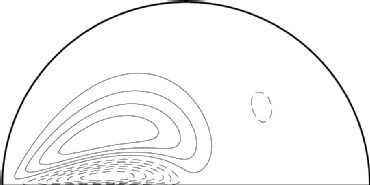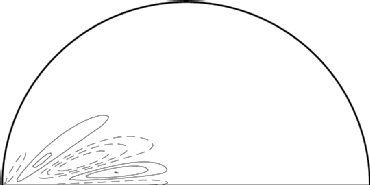Research Interests
Below is a brief summary of some of the research projects I've been involved in over the past few years. If you have any questions, please feel free to drop me an email!
Research Paper | Error bound analysis of the stochastic parareal algorithm
- The aim of this project was to derive rigorous error bounds for the stochastic parareal algorithm (see below), demonstrating that solutions converged to the exact solution in the mean-square sense.
- We derived superlinear and linear error bounds when using stochastic parareal with different types of random perturbations.
- K. Pentland, M. Tamborrino, and T. J. Sullivan. "Error bound analysis of the stochastic parareal algorithm." 2022. (arXivLink opens in a new window).
- Figure: Theoretical bounds vs. numerical errors (against iteration number k) for SParareal applied to a linear system of ODEs using state-independent Gaussian perturbations of decreasing variance. The dashed lines indicate variance levels (left: high, centre: medium, right: low).



Research Paper | GParareal: a time-parallel ODE solver using Gaussian process emulation
- This project involved modelling the correction term, i.e. the difference between coarse- and fine-grained in time solutions, in the parareal algorithm using a Gaussian process (GP) emulator.
- The idea is to use solution information obtained throughout the simulation to learn how the correction term behaves and use the emulator to predict the correction term at unseen input values.
- Numerical results demonstrated that GParareal could outperform the classic parareal algorithm for low-dimensional systems of ODEs.
- K. Pentland, M. Tamborrino, T. J. Sullivan, J. Buchanan, and L.C. Appel. "GParareal: a time-parallel ODE solver using Gaussian process emulation." 2022. Statistics and Computing. 33, 23. (PublicationLink opens in a new window). (arXivLink opens in a new window).
- Figure: Number of iterations (out of a maximum 40), until parareal (left) and GParareal (right) converge to a solution of the FitzHugh-Nagumo ODE systemLink opens in a new window for different initial conditions. Black squares indicate where the parareal algorithm crashed. The lower the number of iterations, the higher the parallel speedup.


Research Paper | Stochastic parareal: an application of probabilistic methods to time-parallelisation
- This paper was the culmination of a first attempt to solve initial value problems (IVPs) by combining time-parallel numerical integration algorithms (specifically the pararealLink opens in a new window algorithm) with probabilistic sampling methods.
- Our numerical results demonstrated that "stochastic parareal" could converge faster than the existing parareal algorithm, given sufficiently many samples are provided during simulation, and would locate solutions of comparable accuracy.
- K. Pentland, M. Tamborrino, D. Samaddar, and L.C. Appel. "Stochastic parareal: an application of probabilistic methods to time-parallelisation." 2022. SIAM J. Sci. Comput. Vol. TBC, No. TBC, pp. S82-S102. (PublicationLink opens in a new window) (arXivLink opens in a new window).
- Figure: (Left) Numerical solution of a nonlinear two-dimensional ODE system in phase space given by a classic fourth-order Runge-Kutta method (black) and stochstic parareal (blue). (Right) Expected convergence rate of stochastic parareal against an increasing number of samples for different sampling rules. Note that parareal takes 20 iterations to converge and a lower convergence rate corresponds to faster parallel speed-up (2000 independent realisations of stochastic parareal were run for each M).


MSc Individual Project | Hats and pancakes in the sky: high-speed droplet dynamics
- A first incursion into the development of models to predict droplet deformation and trajectory in the face of an incoming aerofoil using high resolution direct numerical simulations (DNS) in BasiliskLink opens in a new window.
- Supervised by Dr. Radu CimpeanuLink opens in a new window and Dr. Ed BrambleyLink opens in a new window.
- Figure: Deformation of a half-droplet interface at successive times t = 250, 300 and 350 as the flow field accelerates from the right hand side. Simulations were calculated using an adaptive mesh solver in Basilisk.



MSc Research Group Project | Stochastic parareal: an application of probabilistic methods to time-parallelisation
- An investigation into whether stochastic methods could be incorporated into the parareal algorithm in order to extract further parallel speed-up when integrating systems of ODEs.
- Supervised by Dr. Massimiliano TamborrinoLink opens in a new window, Dr. Debasmita Samaddar and Dr. Lynton Appel.
- Fellow group members: Yijie ZhouLink opens in a new window, Haoran Ni,Link opens in a new window Jimmy McKendrickLink opens in a new window and Jack BaraLink opens in a new window.
- Figure: The pararealLink opens in a new window algorithm in action.

MSc Individual Project | Spin-down in the absence of reflected waves
- Main aims were to reproduce the results from the Physics of Fluids paper Spin-up and spin-down in a half cone: a pathological situation or not? using much simpler analytical and computational techniques and to identify any markedly different/contradictory results.
- Supervised by Prof. Edward JohnsonLink opens in a new window at University College London.
- Figure: A numerical simulation of mass transport streamlines (of an inviscid fluid) building up in the south western corner of the half cone geometry following a spin-down of the fluid (ordering: top left, top right, bottom left, bottom right).
Summer Research Project | Hybrid methods for simulating reaction-diffusion systems
- Ten week internship researching and developing a novel hybrid 'blending' algorithm to combine stochastic simulation algorithms with deterministic partial differential equations in order to simulate reaction-diffusion processes more efficiently.
- Supervised by Dr. Christian YatesLink opens in a new window, University of Bath.
- Figure: Hybrid blending method where particles in a one dimensional domain
jump (diffuse) between compartments in
and
whilst being tracked at their exact positions when moving in
and
.





